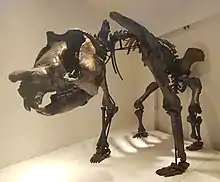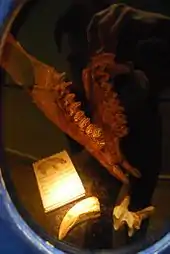Zygomaturus
Zygomaturus[1] is an extinct genus of giant marsupial from Australia during the Pleistocene.

| Zygomaturus Temporal range: Pleistocene | |
|---|---|
 | |
| Skeletal mount of Zygomaturus trilobus at the Melbourne Museum | |
| Scientific classification | |
| Kingdom: | Animalia |
| Phylum: | Chordata |
| Class: | Mammalia |
| Infraclass: | Marsupialia |
| Order: | Diprotodontia |
| Family: | †Diprotodontidae |
| Subfamily: | †Zygomaturinae |
| Genus: | †Zygomaturus Macleay, 1857 |
| Species | |
|
†Zygomaturus diahotensis | |
Description


It was a large animal, weighing 500 kg (1100 lbs) or over 700 kg (1544 lbs)[2] and standing about 1.5 m (4.9 ft) tall and 2.5 m (8.2 ft) long.[3] It rivaled several other Diprotodontidae in size such as Euryzygoma, Euowenia, Nototherium,[4] and was smaller than Diprotodon and Palorchestes.
Palaeobiology
It had a heavy body and thick legs and is believed to be similar to the modern pygmy hippopotamus in both size and build.[5] The genus moved on all fours.[5] Zygomaturus lived in the wet coastal margins of Australia and also is believed to have expanded its range toward the interior of the continent along the waterways.[5] It is believed to have lived solitarily or possibly in small herds. Zygomaturus probably ate reeds and sedges by shovelling them up in clumps with its lower incisor teeth.[5] However, in analysis of remains from Cuddie Springs, the carbon isotope ratios suggests that it consumed both C3 and C4 plants, with a dental microwear texture indicative of browsing,[6]
Extinction
It was once thought that Zygomaturus became extinct about 45,000 years ago[5] until a surprisingly late date of 33-37 Kya is known from the Willandra Lakes Region in New South Wales, the latest known date for any Australian Megafauna. This is well after aboriginal arrival in Australia around 50 Kya.[7]
Related genera
References
- Literal translation "Big cheekbones"
- Peter F. Murray, Patricia Vickers-Rich, 2004, Magnificent Mihirungs: The Colossal Flightless Birds of the Australian Dreamtime, p.326, Indiana University Press
- http://www.megafauna.com.au/view/megafauna/zygomaturus-trilobus/
- Ross D.E. MacPhee, Hans-Dieter Sues, 1999, Extinctions in Near Time, p.251, Springer Science & Business Media
- Ellis, Richard (2004). No Turning Back: The Life and Death of Animal Species. New York: Harper Perennial. pp. 101. ISBN 0-06-055804-0.
- DeSantis, Larisa R. G.; Field, Judith H.; Wroe, Stephen; Dodson, John R. (May 2017). "Dietary responses of Sahul (Pleistocene Australia–New Guinea) megafauna to climate and environmental change". Paleobiology. 43 (2): 181–195. doi:10.1017/pab.2016.50. ISSN 0094-8373.
- Westaway, Michael C.; Olley, Jon; Grün, Rainer (February 2017). "At least 17,000 years of coexistence: Modern humans and megafauna at the Willandra Lakes, South-Eastern Australia". Quaternary Science Reviews. 157: 206–211. doi:10.1016/j.quascirev.2016.11.031.
Further reading
- Wildlife of Gondwana: Dinosaurs and Other Vertebrates from the Ancient Supercontinent (Life of the Past) by Pat Vickers Rich, Thomas Hewitt Rich, Francesco Coffa, and Steven Morton
- Marsupial Nutrition by Ian D. Hume
- Long, J.; Archer, M.; Flannery, T.; Hand, S. (2002). Prehistoric Mammals of Australia and New Guinea: One Hundred Million Years of Evolution. University of New South Wales Press. pp. 98–99. ISBN 978-0-8018-7223-5. OCLC 49860159.
- Life of Marsupials by Hugh Tyndale-Biscoe
- Magnificent Mihirungs: The Colossal Flightless Birds of the Australian Dreamtime (Life of the Past) by Peter F. Murray, Patricia Vickers-Rich, and Pat Vickers Rich
- Classification of Mammals by Malcolm C. McKenna and Susan K. Bell
- Australia's Lost World: Prehistoric Animals of Riversleigh by Michael Archer, Suzanne J. Hand, and Henk Godthelp
- World Encyclopedia of Dinosaurs & Prehistoric Creatures: The Ultimate Visual Reference To 1000 Dinosaurs And Prehistoric Creatures Of Land, Air And Sea ... And Cretaceous Eras (World Encyclopedia) by Dougal Dixon
- The Illustrated Encyclopedia Of Prehistoric Life by Dougal Dixon

.jpg.webp)